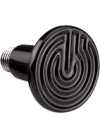SanctuaryHills
Active Member
Looked through Amazon for them and only find results for self regulating "heat cables". I'm wondering if there is such thing as a self regulating lamp. I'd need one that can maintain 75° with temps in an outdoor enclosure that fluctuates from 35° to 69° during winter time (South Florida)
So far I'm using a heat dome that can house two 150W bulbs (300W max) to archive those results, but I constantly have to play with different combinations of those two bulbs to maintain the temp I want as the temperature shifts.
For context these are Aldabra tortoises less than a year old and they only go in the heated wooden enclosure at night. In the daytime they have a covered pen where they can sunbathe, forage, and walk around. There are occasions where I have to keep them inside the heated night box during daytime hours but those are VERY rare days.
I appreciate the advise!
So far I'm using a heat dome that can house two 150W bulbs (300W max) to archive those results, but I constantly have to play with different combinations of those two bulbs to maintain the temp I want as the temperature shifts.
For context these are Aldabra tortoises less than a year old and they only go in the heated wooden enclosure at night. In the daytime they have a covered pen where they can sunbathe, forage, and walk around. There are occasions where I have to keep them inside the heated night box during daytime hours but those are VERY rare days.
I appreciate the advise!

